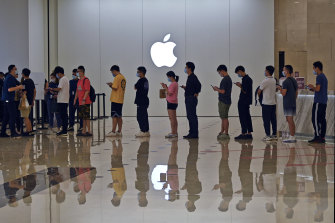

Apple, suffering from a global supply crunch, is now confronting a different problem: slowing demand.
The company has told its component suppliers that demand for the iPhone 13 lineup has weakened, people familiar with the matter said, signalling that some consumers have decided against trying to get the hard-to-find item.

People were lining up at Apple Stores initially to buy the latest iPhone 13 handsets, but demand has weakened. Credit:AP
Already, Apple had cut its iPhone 13 production goal for this year by as many as 10 million units, down from a target of 90 million, because of a lack of parts, Bloomberg News reported. But the hope was to make up much of that shortfall next year -- when supply is expected to improve. The company is now informing its vendors that those orders may not materialise, according to the people, who asked not to be identified because the discussions are private.
The company is still on track for a record Christmas season, with analysts projecting a sales increase of 6 per cent to $US117.9 billion ($166 billion) in the final three months of the calendar year. But it won’t be the blockbuster quarter that Apple -- and Wall Street -- had originally envisioned. Shortages and delivery delays have frustrated many consumers. And with inflation and the Omicron variant bringing fresh concerns to pandemic-weary shoppers, they may forego some purchases.
That could mean skipping the iPhone 13 altogether and waiting to upgrade next year, when its successor comes out. The current lineup, which starts at $1199 for the standard model and $1699 for the Pro, is considered a modest update from the iPhone 12, which had a whole new design. Bigger changes are expected for the 2022 model, giving some shoppers a reason to wait.
Apple, based in Cupertino, California, declined to comment.
The iPhone is Apple’s flagship product, accounting for about half of its $US365.8 billion in revenue during the last fiscal year, and rolling out upgrades is a delicate dance. With the iPhone 13, Apple and wireless carriers unleashed aggressive rebate programs to spur purchases. In some cases, owners of an iPhone 12 or earlier models were able to buy an iPhone 13 at little to no cost. While discount programs are still available, some offer less dramatic savings than when new models first went on sale.
During Apple’s last earnings call in October, Chief Executive Officer Tim Cook said that demand for new products was “very robust” -- fuelled by interest in the latest iPhones, iPads and other devices -- and that the company was on track for a record Christmas quarter. It had sales of $US111.4 billion in the year-earlier period.









 Add Category
Add Category